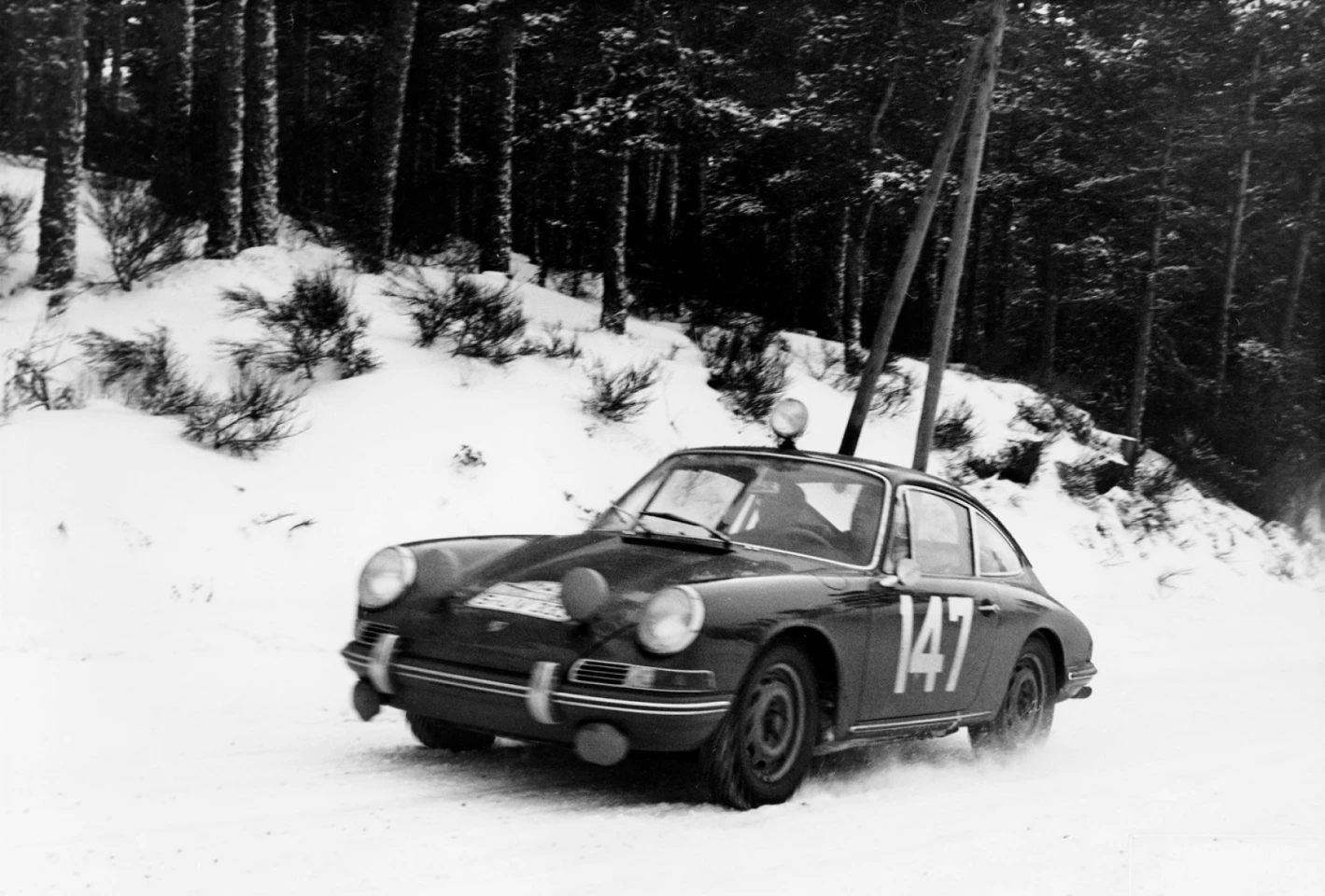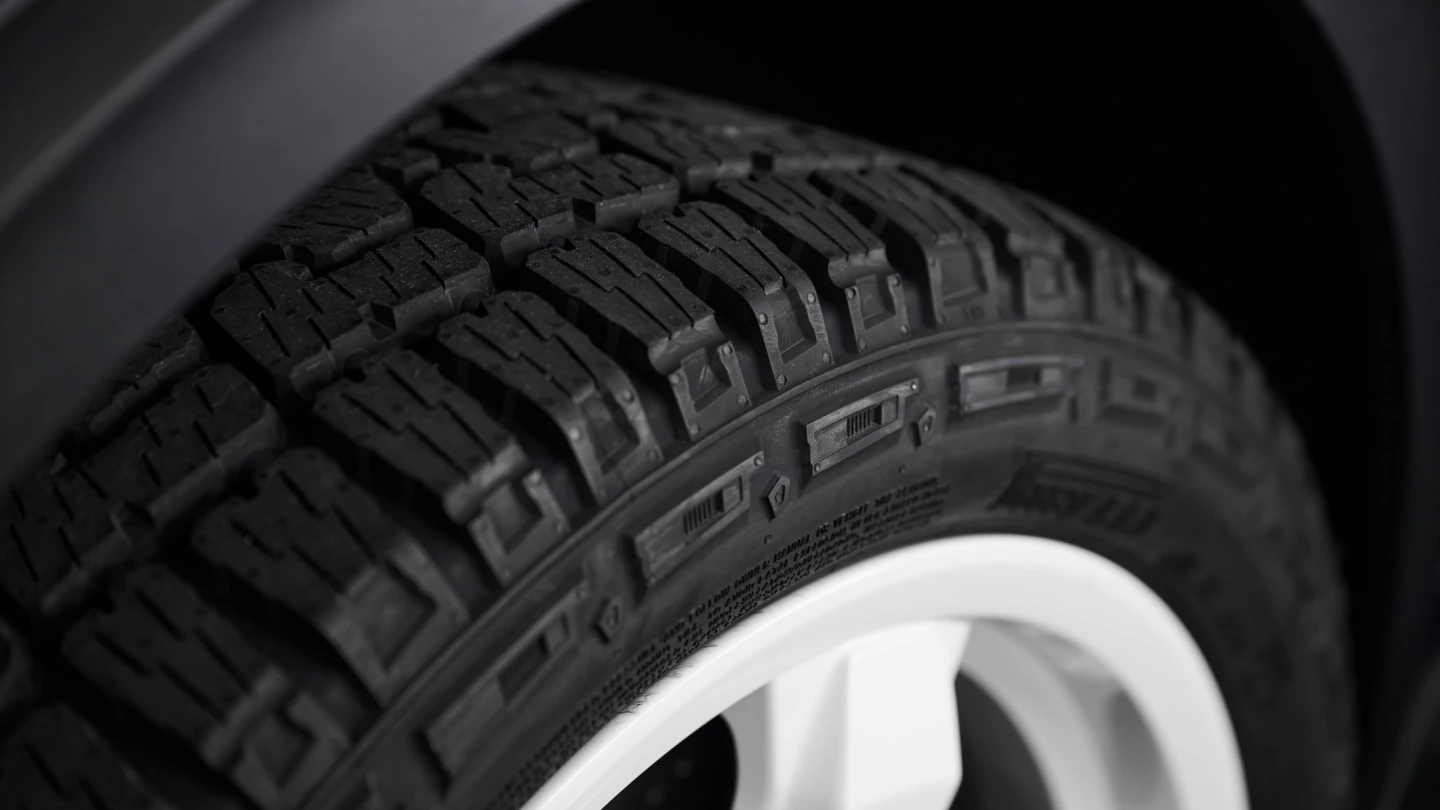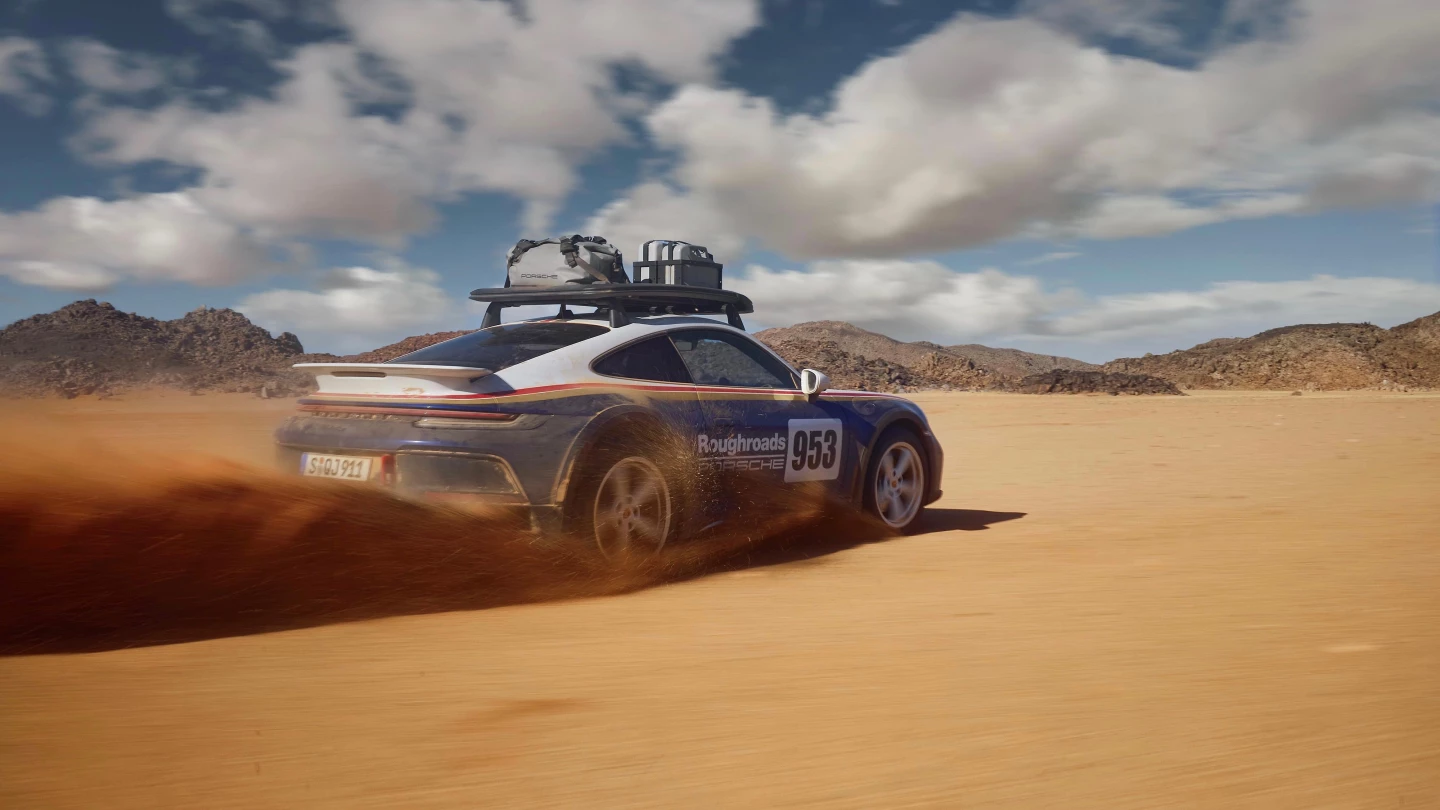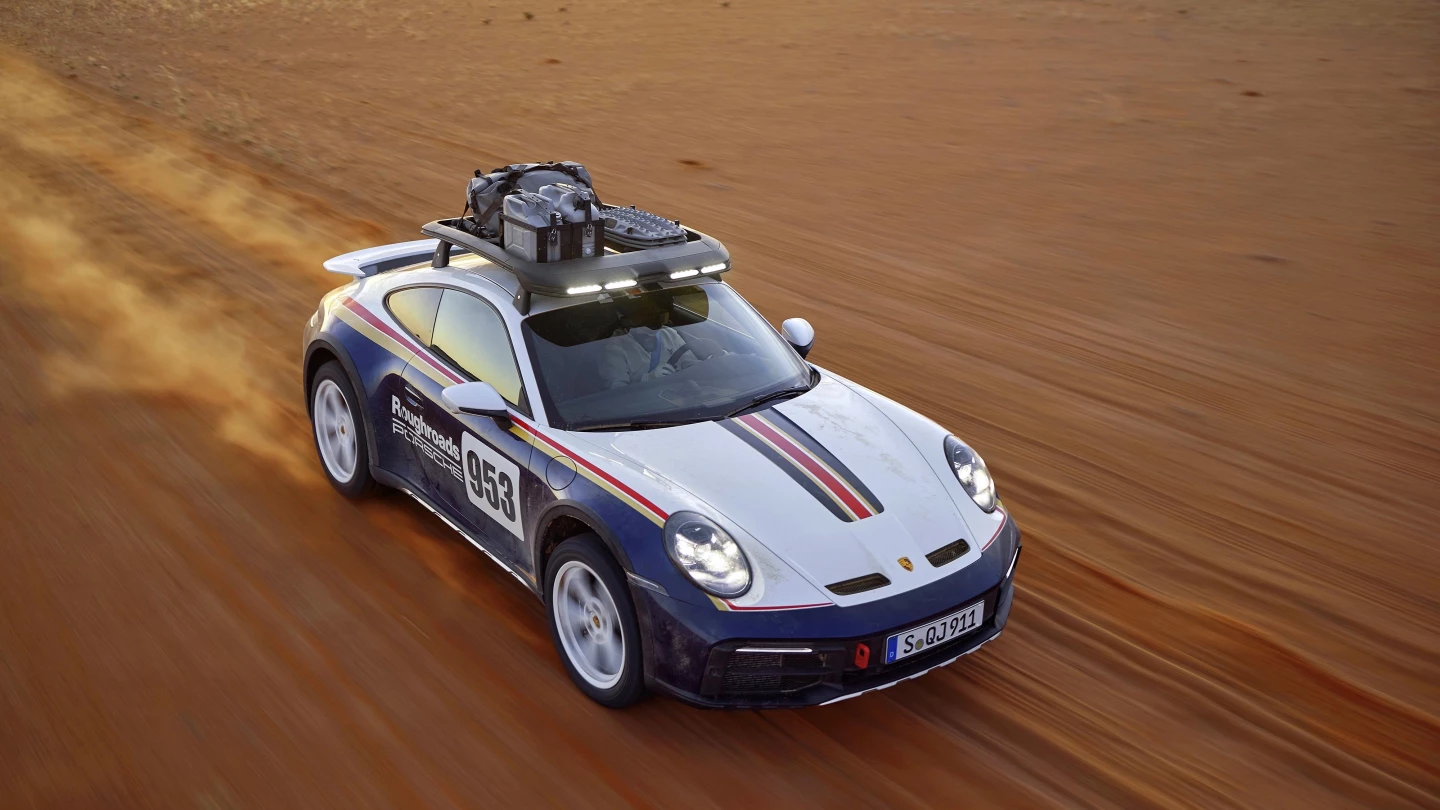The Porsche 911 has a proud history as a legit off-road competitor, from winning Dakar back in 1984 to climbing the world's tallest volcano just last week. But that competitive history has been just that: competition 911s built to task for professional drivers on official off-road courses, tracks and factory-backed missions, mostly in decades long past. Now, in an unprecedented move, Porsche has introduced the 911 Dakar, a limited-edition road-legal 911 sports off-roader meant to rally or overland the day away in the hands of a regular owner before rolling up fashionably late to a five-star dinner ... after a quick run through the car wash, of course.
The heritage
To those who don't follow such things, the idea of a 911 off-roader may very well seem so foreign as to be ridiculous, the fodder of a mad tuner with too much time and too wealthy a client base. But 911 off-roading – and we're not talking just driving a 911 Carrera 4S to a forest road trailhead – is nearly as old as the 911 itself, baked into the model's DNA.
It was actually the Porsche 911's first-ever motorsport event that laid the groundwork for a short but memorable factory off-road racing career. In 1965, not two full years after the 911's 1963 Frankfurt Motor Show debut and mere months after its market launch, Porsche's works team decided to enter a 911, modified only slightly from stock, in the 1965 Monte-Carlo Rally.
Porsche's purpose wasn't to win – the team also raced a mid-engined 904 that nearly did that, taking second place. Instead, in an effort led by Huschke von Hanstein, uniquely qualified as a two-hat exec that served as Porsche's racing director and press officer, the idea was to draw attention to the new 911's dual-purpose design: a gentleman's sports car during the week, a daredevil's race car on the weekend. The glamorous and international Monte-Carlo race was identified as the ultimate backdrop for the campaign.

As is often the case for the Monte-Carlo Rally, held in January in the French Alps, the asphalt race circuit was buried in snow that year. The 911 team of Herbert Linge and Peter Falk soldiered through the treacherous conditions and finished the race in a respectable fifth place ... not bad for a PR stunt. More importantly, the finish proved the 911 a capable rally machine, leading to a hat trick of Monte-Carlo victories in 1968, '69 and '70.
It wasn't until the 1970s that Porsche prepped the 911 for all-out off-road rally racing, torturing a specially equipped car over the thousands of miles of cold-blooded, untamed wild lands that featured in the East African Safari Rally. It was here the 911 SC Safari car was born. It never won in several attempts, but it came close in its last and most famous in 1978, finishing second.

It was the 1980s that saw full victory and triumph rise from Porsche's 911 off-road rallying efforts. With a team of Rene Metgé and Dominique Lemoyne at its helm, the 911 4x4 won the 1984 Paris-Dakar rally, making use of the 911's first-ever all-wheel drive. That AWD system found its way into the soon-to-be-legendary 959, which won Dakar in 1986 on its way to becoming one of the era's most revered high-tech supercars.
Porsche's rally presence thinned from there, leaving future 911 rally efforts in the hands of privateers, but the history was cemented and never forgotten. In fact, the Porsche 911 Safari car has become something of a reborn legend among rally and off-road enthusiasts and even motorsport and car fanatics in general. New interest has led to a renaissance of off-road Porsche sports car designs from DIY builders, restomod businesses and even ambitious Antarctic explorers.

Porsche itself played with the idea of a 21st century 911 Safari car revival in 2012, albeit in secrecy. It transformed a 991-gen 911 into a working Vision Safari prototype directly inspired by the 1978 East African Safari cars. Unfortunately, that concept car never made a formal debut, and Porsche didn't even make its existence public until it detailed a number of never-before-publicized design studies as part of the Unseen project in 2020.
The car
Now, 10 years on from the Vision Safari, Porsche has launched the much more official 911 Dakar at the 2022 LA Auto Show. While it's still a little bit of a shock to the system to see a factory off-road 911 customer car actually materialize, it's an effort that has the fierce winds of a perfect storm at its back.
In addition to the aforementioned contemporary resurgence in 911 Safari car interest, and ensuing third-party reinterpretations, Porsche itself has leaned more into off-road(ish) endeavors with its SUVs, models like the Taycan Cross Turismo, and even rooftop camping experiences and factory accessories. Compound all that and one's left with a very reasonable answer to the question, "Why now ... 38 and 5/6 years after Dakar 1984??"

The limited-run 911 Dakar falls short of the portal axles and bloated tires on the 2022 911 volcano climber duo but does get a lift of 2 inches (50 mm) compared to a 911 Carerra with sport suspension. The upgraded suspension system can also raise the Dakar's front and rear by an additional 1.2 in (30 mm) when dialed to its highest setting, giving the car a ground clearance and breakover angle akin to an SUV. The Dakar can then travel at speeds up to 105 mph (169 km/h) before the system automatically drops it back down to normal height to ensure 911-like handling and stability.
The 911 Dakar plants specially developed Pirelli Scorpion All Terrain Plus tires in the dirt, ensuring it goes where the driver intends when they intend it, no matter how uncooperative the ground below. Those tires size 245/45 ZR 19 up front and 295/40 ZR 20 out back and feature a 9-mm tread depth and reinforced sidewalls for hardwearing off-road performance.

The Dakar rumbles forward over sand, rock, slush and macadam under power from Porshe's 3.0-liter twin-turbo boxer six teamed with a standard eight-speed PDK transmission and all-wheel drive for 473 hp (350 kW) and 420 lb-ft (570 Nm) of torque. The car can sprint from 0 to 62 mph (100 km/h) in 3.4 seconds, though assuredly not across mushy, tire-sucking gloop. Top speed is limited to 150 mph (240 km/h) so as not to push those AT tires way out of their comfort zone.
Porsche adds two new push-button driving modes to the mix to quickly optimize the 911's essential systems and components for off-road environments. "Off-Road" mode does as it implies, kicking the Dakar into its highest clearance and readying systems for enhanced traction on rough, slippery unimproved terrain. "Rallye" mode helps steady things out on stretches of loose, uneven ground, instituting a rear bias in all-wheel-drive distribution.
Both modes also feature a new Rallye Launch Control to improve acceleration on the loose, shifty conditions under the tires. Standard rear-axle steering and body roll-inhibiting Porsche Dynamic Chassis Control further aid in off-road stability and maneuvering.

Other off-road-specific modifications include pebble-blocking stainless steel grilles over the front intakes, steel front, rear and side sill protection, flared fenders, and front and rear aluminum tow hooks. A 12-V outlet on the roof is ready and waiting to plug and play the optional 92-lb-capacity (42-kg) roof rack with integrated headlights. Porsche also extends its newly launched rooftop tent option to the 911 Dakar, allowing buyers to quickly turn it into a high-performance overland micro-camper quite unlike anything else likely to be parked within hundreds of miles of camp.

A fixed rear wing and the 911 GT3's carbon hood complete with nostrils round out the exterior kit.
Those who want to more loudly advertise the car's 1984 Dakar 911 4x4 ties can opt in on the available Rallye Design Package to splash on flair reincarnated from the mid-80s rallying world. This package includes the dual-tone white and "Gentian Blue Metallic" coloring, painted white rims, buyer's choice of "race" number between 0 and 999, trademarked "Roughroads" lettering, and full-width taillight strip.
The 911 Dakar is officially a driver/co-driver affair, as the rear seats are cut out entirely to help keep weight down to 3,552 lb (1,611 kg). The two bucket seats are upholstered in Race-Tex with green stitching.

Before debuting the 911 Dakar at this week's LA Auto Show, Porsche put it through a worldwide testing regimen that saw it four-wheel the scorching sands of Dubai and Morocco, the ice and snow of Sweden, and the winding, hilly dirt of France's Château de Lastours rally testing grounds. That's not to mention the nearly 300,000 testing miles (483K km) it spent on asphalt to ensure every bolt is torqued and tweaked to maintain the utmost performance of a proper 911 ... one that isn't at all afraid to get absolutely filthy.
Porsche plans to build 2,500 911 Dakar examples worldwide. They will begin arriving at US dealerships in (Northern Hemisphere) spring 2023 for a starting price of $223,450, including delivery, processing and handling.
And yes, there's video:
Source: Porsche






























